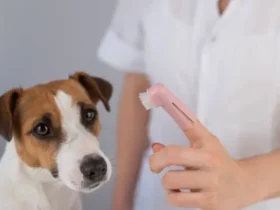Tear stains are a common issue among many dog breeds, particularly those with light-colored fur or brachycephalic (short-nosed) faces. These unsightly marks can be frustrating to manage, but with the right approach, you can effectively remove and prevent them. In this comprehensive guide, we’ll explore the causes of tear stains, how to treat them, and tips for keeping your dog’s eyes clean and stain-free.
1. Understanding Tear Stains
- What Are Tear Stains? Tear stains are reddish-brown marks that appear below a dog’s eyes, caused by the overflow of tears that stain the fur.
- Commonly Affected Breeds: Breeds like Maltese, Shih Tzu, Poodle, and Bichon Frise are particularly prone to tear stains due to their facial structure and light-colored fur.
- Why It Happens: Tear stains occur when excess tears overflow from the eyes and come into contact with the fur. The staining is often due to porphyrins, a substance found in tears that turns brown or reddish when exposed to light.
2. Causes of Tear Stains
- Facial Anatomy: Dogs with shallow eye sockets or short noses may have difficulty draining tears properly, leading to overflow.
- Blocked Tear Ducts: Tear ducts that are partially or fully blocked can prevent proper tear drainage, leading to tear stains.
- Eye Infections: Infections or irritations in the eyes can cause excessive tearing, which may lead to staining.
- Allergies: Environmental or food allergies can cause tear overproduction, contributing to tear stains.
- Poor Diet: A diet high in additives, fillers, and artificial ingredients can exacerbate tear staining in some dogs.
- Teething in Puppies: Tear staining can be more prominent in puppies during teething due to increased tear production.
3. Identifying the Underlying Cause
- Veterinary Examination: If your dog has persistent tear stains, a visit to the vet is essential to rule out any underlying medical issues like infections or blocked tear ducts.
- Allergy Testing: If allergies are suspected, your vet may recommend allergy testing to identify specific triggers that cause excessive tearing.
- Diet Assessment: Evaluate your dog’s diet to ensure it’s free of common allergens and artificial ingredients that could contribute to tear staining.
4. How to Treat Tear Stains
- Daily Eye Cleaning Routine:
- Wipe Regularly: Use a soft, damp cloth or cotton pad to gently wipe around your dog’s eyes daily. This helps remove any accumulated tears before they can stain the fur.
- Tear Stain Remover: Consider using a tear stain remover specifically designed for dogs. These products can help break down and remove existing stains while preventing new ones from forming.
- Saline Solution: A mild saline solution can be used to clean your dog’s eyes and help reduce staining. Apply it with a clean cotton pad and gently wipe the affected area.
- Grooming: Regular grooming is crucial in managing tear stains. Keep the hair around your dog’s eyes trimmed to prevent irritation and tear accumulation.
- Dietary Supplements: Some supplements, such as those containing probiotics or cranberry extract, can help reduce tear staining by improving overall eye health and reducing tear production.
- Campbell’s Tip: “Consistency is key in treating tear stains. Establish a daily cleaning routine and stick to it to see the best results.”
5. Preventing Tear Stains
- Dietary Changes: Switch to a high-quality, grain-free diet free of artificial preservatives, colors, and fillers. A balanced diet can help reduce tear production and staining.
- Clean Water: Provide your dog with clean, filtered water. Minerals in tap water can contribute to tear staining in some dogs.
- Regular Eye Checks: Regularly inspect your dog’s eyes for signs of irritation, redness, or excessive tearing. Early intervention can prevent tear stains from becoming severe.
- Maintain a Clean Environment: Keep your dog’s living area clean and free of dust and allergens that could irritate their eyes.
- Use Stainless Steel or Ceramic Bowls: Plastic bowls can harbor bacteria that may contribute to tear staining. Opt for stainless steel or ceramic bowls instead.
- Campbell’s Insight: “Prevention is the best approach to managing tear stains. By addressing the root causes and maintaining good hygiene, you can keep your dog’s eyes clear and stain-free.”
6. Home Remedies for Tear Stains
- Apple Cider Vinegar: Adding a small amount of apple cider vinegar to your dog’s water can help balance the pH levels in their body, which may reduce tear staining. Start with a teaspoon per 50 pounds of body weight.
- Coconut Oil: Applying a small amount of coconut oil around the eyes can help repel moisture and prevent tear stains from forming. Be sure not to get it in your dog’s eyes.
- Chamomile Tea: Chamomile tea has soothing properties that can help reduce eye irritation and staining. Brew the tea, let it cool, and use it to gently clean the area around the eyes.
- Hydrogen Peroxide Mixture: A diluted hydrogen peroxide solution (1 part hydrogen peroxide to 10 parts water) can be used to carefully clean tear stains. Be extremely cautious to avoid getting it in your dog’s eyes.
- Campbell’s Caution: “While home remedies can be effective, always consult your vet before trying any new treatment to ensure it’s safe for your dog.”
7. Professional Treatments
- Grooming Services: Professional groomers can offer specialized treatments for tear stains, including deep cleaning and trimming the fur around the eyes.
- Veterinary-Grade Products: Some veterinarians offer prescription-strength tear stain removers that may be more effective than over-the-counter options.
- Surgery: In severe cases where tear ducts are blocked or facial anatomy is causing excessive tearing, surgical intervention may be recommended to correct the issue and reduce tear staining.
- Campbell’s Advice: “For stubborn tear stains that don’t respond to home treatments, professional help may be necessary. Your vet or groomer can provide more intensive care options.”
8. Managing Tear Stains in Puppies
- Gentle Cleaning: Puppies are more sensitive, so use a gentle approach when cleaning their eyes. A soft, damp cloth or a saline solution is usually sufficient.
- Teething Considerations: Be aware that tear staining may increase during teething. Maintain a regular cleaning routine to manage it during this time.
- Puppy-Specific Products: Use tear stain removers formulated specifically for puppies, as their skin and eyes are more delicate.
- Campbell’s Note: “Puppies require extra care when it comes to tear stains. Be gentle and patient, and consult your vet if the stains persist.”
9. Special Considerations for Brachycephalic Breeds
- Why These Breeds Are Prone: Breeds like Bulldogs, Pugs, and Shih Tzus have a flat facial structure that can lead to poor tear drainage and increased tear staining.
- Tailored Care: For these breeds, it’s essential to keep the facial folds clean and dry to prevent tear stains and infections. Use a damp cloth or a veterinary-approved cleaner to wipe the folds regularly.
- Regular Vet Visits: Due to their unique anatomy, brachycephalic breeds may require more frequent vet check-ups to monitor eye health and tear production.
- Campbell’s Insight: “Brachycephalic breeds need special attention when it comes to tear stains. Regular care and monitoring are crucial to prevent complications.”
10. When to See a Vet
- Persistent Staining: If your dog’s tear stains persist despite regular cleaning and care, it’s time to consult a vet to rule out underlying health issues.
- Signs of Infection: Redness, swelling, or a foul odor around the eyes may indicate an infection, which requires veterinary attention.
- Eye Irritation: If your dog is frequently rubbing their eyes or showing signs of discomfort, a vet visit is necessary to diagnose and treat the issue.
- Campbell’s Recommendation: “Don’t ignore persistent tear stains or signs of irritation. Early intervention by a vet can prevent more serious problems from developing.”
Conclusion
Tear stains can be a frustrating issue for dog owners, but with the right knowledge and approach, you can effectively manage and prevent them. By understanding the causes of tear stains, implementing a consistent cleaning routine, and making necessary dietary and environmental adjustments, you can keep your dog’s eyes clear and healthy.
Veterinarian Courtney Campbell’s expert advice provides a comprehensive guide to tackling tear stains, ensuring that your dog’s eyes remain bright and stain-free. Whether through daily care, home remedies, or professional treatments, you have the tools to keep your furry friend looking and feeling their best.
4o











Leave a Reply